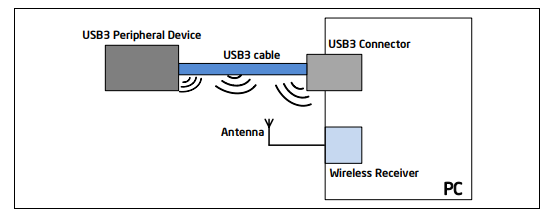There is a possibility that USB 2.0 is less susceptible to noise than USB 3.0.
2.4 GHz wireless devices
The 2.4 GHz ISM band is a widely used unlicensed radio frequency band for devices such as wireless routers, as well as wireless PC peripherals such as a mouse or keyboard. These devices may use standard protocols such as the IEEE 802.11b/g/n, or they may use proprietary protocols.
The radios may use frequency hopping, frequency agility, or may operate on a fixed frequency. In order for a wireless radio receiver to detect the received signal correctly, the received signal power must be greater than the sensitivity of the radio. The sensitivity limit of the receiver is influenced by the minimum signal-to-noise ratio (SNR) required for demodulation. The receiver sensitivity, transmitted signal power, receive and transmit antenna gain, and wireless link path loss dictates the achievable wireless range by determining the signal and noise power at the receiver.
Any wired signal will radiate electromagnetic waves unless it is direct current (no frequency change) or completely shielded. The intensity of interference is related to the signal (such as voltage, current, frequency) transmitted on the cable.
USB 3.0
USB 3.0 uses 4 data lines to form 2 groups, that is, USB3.0 has two high-speed line pairs. The two-wire pairs perform TX and RX transmission respectively, so USB3.0 is a full-duplex 500MBps. The transfer rate on each pair is 500MBps*8 (Byte→bit)/(8/10) (USB3.0 is 8B/10B encoding, that is, 8 of the 10 data are actually transmitted) = 5Gbps. The reference frequency of each data line is 2.5 GHz. 2.5 GHz is too close to the frequency of 2.4GHz devices, and because most high-frequency equipment uses SSC technology, the signal is not completely distributed on a fixed frequency.
When USB 3.0 is in use, it will add about 20dB of noise in the 2.4G band, causing radio frequency interference to the 2.4GHz ISM band. This interference will reduce the sensitivity of wireless reception, thereby reducing the range of reception, which is enough to affect the normal use of interfering wireless devices (wireless network cards, wireless mice, wireless headphones, etc.).


![[사은품 이벤트] 출시~! 하이파이로즈 RS130 네트워크 트랜스포트 출시 기념 리뷰 및 청음 영상 예약구매 이벤트까지](https://i.ytimg.com/vi/UNR1GvNxk8Y/maxresdefault.jpg)


![[Product Overview] RS130_Ultimate Network Transport (Eng Sub)](https://i.ytimg.com/vi/M4Un8SiOwns/maxresdefault.jpg)
